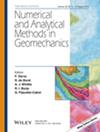Compacting Effect Study on the Treatment of Collapsible Loess Foundation by the SDDC Method: Numerical and Experimental Analysis
IF 3.4
2区 工程技术
Q2 ENGINEERING, GEOLOGICAL
International Journal for Numerical and Analytical Methods in Geomechanics
Pub Date : 2025-05-27
DOI:10.1002/nag.4002
引用次数: 0
Abstract
An optimal design scheme is developed for treating collapsible loess foundation by the super down‐hole dynamic compaction method (SDDC) in terms of the loess foundation treatment project. This method involves the application of high‐energy impacts to the soil to achieve a compacting effect (CE), which is defined as the measurable improvement in soil density and reduction in its collapsibility. The compaction effect of loess particles and different SDDC parameters on collapsible loess foundation is simulated by the discrete element method (DEM) based on particle flow PFC software, and the optimization scheme is verified by field test data. The results indicates that the SDDC method is more effective for the foundation with uniform soil particle distribution with fine particle size, while the influence of initial porosity, shear modulus, and Poisson's ratio of soil on foundation CE is not significant. For a single pile, the CE of the foundation can be improved by increasing the compaction energy and the diameter of the hammer head, increasing the compaction energy, and reducing the diameter of the drill hole and the distance between piles. The CE performance of an olivary hammer is better than a pointed hammer. Finally, the design parameters of the SDDC construction method in this site are determined as follows: The down‐hole diameterSDDC法处理湿陷性黄土地基的压实效果研究:数值与试验分析
结合黄土地基处理工程,提出了超井下强夯法(SDDC)处理湿陷性黄土地基的优化设计方案。这种方法涉及对土壤施加高能冲击以达到压实效果(CE),这被定义为土壤密度的可测量改善和其湿陷性的减少。采用基于颗粒流PFC软件的离散元法(DEM)模拟了黄土颗粒和不同SDDC参数对湿陷性黄土地基的压实效果,并通过现场试验数据验证了优化方案。结果表明,SDDC方法对粒径较细、粒径分布均匀的地基更为有效,初始孔隙率、剪切模量和泊松比对地基CE的影响不显著。对于单桩,可以通过增大压实能量和锤头直径,增大压实能量,减小钻孔直径和桩间距离来提高基础的CE。橄榄锤的CE性能优于尖锤。最终确定本场地SDDC施工方法的设计参数为:井下直径D0 = 1.2 m,桩距L = 2.8 ~ 3.2 m,采用橄榄锤施工。
本文章由计算机程序翻译,如有差异,请以英文原文为准。
求助全文
约1分钟内获得全文
求助全文
来源期刊
CiteScore
6.40
自引率
12.50%
发文量
160
审稿时长
9 months
期刊介绍:
The journal welcomes manuscripts that substantially contribute to the understanding of the complex mechanical behaviour of geomaterials (soils, rocks, concrete, ice, snow, and powders), through innovative experimental techniques, and/or through the development of novel numerical or hybrid experimental/numerical modelling concepts in geomechanics. Topics of interest include instabilities and localization, interface and surface phenomena, fracture and failure, multi-physics and other time-dependent phenomena, micromechanics and multi-scale methods, and inverse analysis and stochastic methods. Papers related to energy and environmental issues are particularly welcome. The illustration of the proposed methods and techniques to engineering problems is encouraged. However, manuscripts dealing with applications of existing methods, or proposing incremental improvements to existing methods – in particular marginal extensions of existing analytical solutions or numerical methods – will not be considered for review.

 求助内容:
求助内容: 应助结果提醒方式:
应助结果提醒方式:


